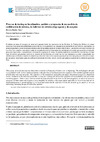Identificador persistente para citar o vincular este elemento:
https://accedacris.ulpgc.es/jspui/handle/10553/76116
| Campo DC | Valor | idioma |
|---|---|---|
| dc.contributor.author | Bailén Ruiz, Beatriz | en_US |
| dc.date.accessioned | 2020-11-30T12:31:31Z | - |
| dc.date.available | 2020-11-30T12:31:31Z | - |
| dc.date.issued | 2020 | en_US |
| dc.identifier.issn | 2340-8561 | en_US |
| dc.identifier.uri | https://accedacris.ulpgc.es/handle/10553/76116 | - |
| dc.description.abstract | El debate en torno al concepto de error está presente desde los comienzos de los Estudios de Traducción. Debido al avance tecnológico en un mundo globalizado como el de hoy se ha producido un aumento en la prestación de servicios de localización; un proceso que abarca un mayor número de tareas de distinta índole aparte de la traducción de texto. Los objetivos de esta investigación son describir y analizar conceptos a modo de recopilación teórica, determinar los parámetros necesarios para proceder al testeo de productos localizados y estandarizar y sistematizar el proceso de testeo. Se plantea también la necesidad de analizar los distintos tipos de errores que pueden darse en un proceso de localización, así como realizar una taxonomía de estos, proponiendo una codificación y creando un modelo de informe aplicable en la fase de revisión del proceso de localización junto con unas instrucciones de uso para el localizador, para así unificar el proceso de revisión y testeo, con el consiguiente aumento de la calidad del producto final. | en_US |
| dc.description.abstract | The concept of translation error has been under discussion in Translation Studies since its beginnings. The technological advance in a globalised world like this implies an increase in the provision of localisation services; a process which includes a greater number of tasks other than translating text. The objectives of this research are to describe and analyse theoretical concepts as a theoretical review; to determine the necessary parameters to carry out a testing task of localised products and to standardise and systematise the testing process. There is also a need to analyse the types of errors being made in a localisation process, as well as to conduct a taxonomy of these errors and propose an error encoding. In addition, a bug report model applicable in the revision phase of the localisation process is created together with a set of instructions for the localisers with the aim of unifying the process of revision and testing, increasing the quality of the final product. | en_US |
| dc.language | spa | en_US |
| dc.relation.ispartof | LFE. Revista de Lenguas para Fines Específicos | en_US |
| dc.source | LFE. Revista de lenguas para fines específicos [eISSN 2340-8561], v. 26 (1), p. 9-25 | en_US |
| dc.subject | 570107 Lengua y literatura | en_US |
| dc.subject | 550510 Filología | en_US |
| dc.subject.other | Testeo | en_US |
| dc.subject.other | Taxonomía de errores | en_US |
| dc.subject.other | Codificación de errores | en_US |
| dc.subject.other | Testeo lingúístico | en_US |
| dc.subject.other | Testeo funcional | en_US |
| dc.subject.other | Informe de errores | en_US |
| dc.subject.other | Testing | en_US |
| dc.subject.other | Taxonomy of errors | en_US |
| dc.subject.other | Error encoding | en_US |
| dc.subject.other | Linguistic testing | en_US |
| dc.subject.other | Functional testing | en_US |
| dc.subject.other | Bug report | en_US |
| dc.title | Proceso de testing en localización: análisis y propuesta de un modelo de codificación de errores, de informe de errores (bug report) y de test plan | en_US |
| dc.type | info:eu-repo/semantics/article | - |
| dc.type | Article | - |
| dc.identifier.doi | 10.20420/rlfe.2020.310 | en_US |
| dc.description.lastpage | 25 | en_US |
| dc.description.firstpage | 9 | en_US |
| dc.investigacion | Artes y Humanidades | en_US |
| dc.type2 | Artículo | - |
| dc.identifier.ulpgc | Sí | en_US |
| dc.description.esci | ESCI | |
| dc.description.fecytq | Q3 | |
| dc.description.fecytpuntuacion | 27,02 | |
| dc.description.dialnetimpact | 0,0 | |
| dc.description.dialnetq | Q1 | |
| dc.description.dialnetd | D1 | |
| dc.description.erihplus | ERIH PLUS | |
| item.fulltext | Con texto completo | - |
| item.grantfulltext | open | - |
| Colección: | Artículos | |
Visitas
304
actualizado el 25-ene-2025
Descargas
226
actualizado el 25-ene-2025
Google ScholarTM
Verifica
Altmetric
Comparte
Exporta metadatos
Los elementos en ULPGC accedaCRIS están protegidos por derechos de autor con todos los derechos reservados, a menos que se indique lo contrario.
